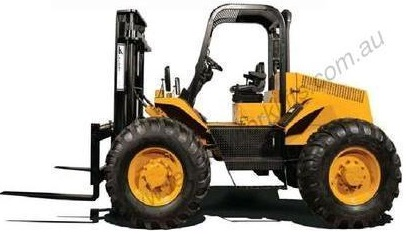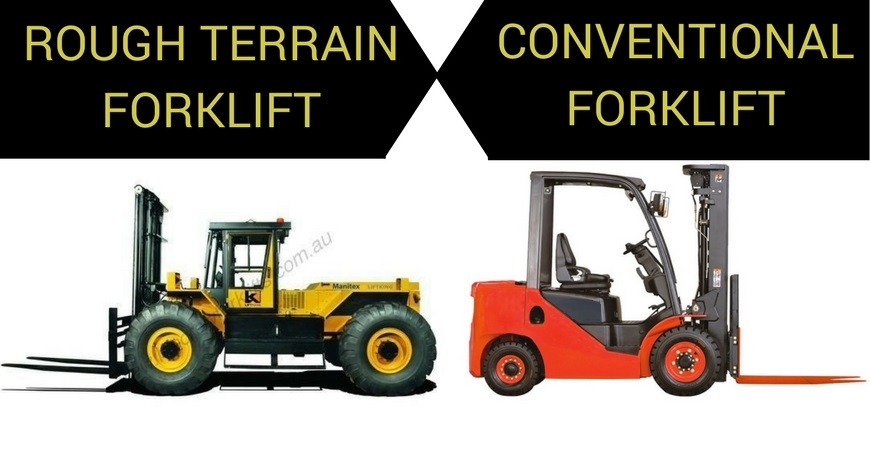
Workplace ground surfaces vary from operation to operation – from the hard surface of a warehouse to the rocky, uneven and sometimes muddy conditions of a mine pit. It is important to have qualified staff with knowledge of how their equipment operates. On this note, it is imperative that a business provides their employees with the appropriate equipment designed to suit all conditions. At Lencrow we have equipment solutions for you and we specialize in rough terrain forklifts with capacities starting at 2 tonne to 25 tonne. Click on the link below to find out more.

There is a big difference between rough terrain forklifts and conventional forklifts. Rough terrain forklifts are built to undertake hard terrains and bear difficult conditions. They often look like a crossover between a tractor and a forklift, which is quite fitting because they perform an identical task to both kinds of vehicles and in a similar location.
Rough terrain forklifts come in 2WD and 4WD variants; however, 4WD variant is the all-rounder that can accomplish all kinds of difficult tasks on rough terrain. In this segment, the 4WD forklifts are the heavy lifters having big wheels with a driver’s mount and a fork. When handling loads, these rough terrain forklifts remain highly balanced.
Furthermore, these rough terrain forklifts double as workhorses in the bush here in Australia. They drive neatly on soils and they are extremely strong and lasting. In the location where no conventional forklift could operate, a rough terrain forklift variant can effortlessly carry out the task.
Moreover, these forklifts are very flexible and they come with a range of attachments. Rough terrain forklifts use a telescopic or a standard mast, which can be quite handy when handling a complex-mix of reach and lift. These rough terrain forklifts come with a higher ground clearance that is crucial to work on cross-country terrain.
Rough terrain forklifts are larger than the majority of conventional forklifts and they are not suitable for indoor tasks.
Rough Terrain Forklift Choices & Cost Considerations
Rough terrain forklifts are larger, stronger and more durable and hence they are pricey than the average forklift. Rough terrain forklifts come not only in different designs and specifications but also with a variety of forklift options, which make them truly exceptional.
No matter whether you are searching for a quality rough terrain forklift or a conventional forklift, it is always an excellent idea to shop around to get the best deal. Typically, you will find high-quality rough terrain forklifts for sale with established dealers who have years of experience under their belt.
Rough Terrain Forklift Applications
Essential Tips
Why is it so important to select the right forklift for the task?
It is important to select the right forklift for the task as it influences nearly everything, right from operating costs to employee productivity and employee morale including inventory management. There is a huge range of forklifts available and each one is intended for a particular task, so how to identify the right kind of forklift for your business? Well, you need to consider many aspects when choosing the right forklift for your business, which can include:
1. Location
The location of your business will determine the type of forklift, fuel and tyre. Look at the conditions the forklift has to work including the floor surface. In addition, get answers to the following questions.
2. Type of Fuel
The different fuel options are LPG/petrol, diesel and electric. Initially, electric forklifts will cost more, but eventually, you will enjoy the benefits because they last longer and have an economical fuel intake when compared to other forklifts types. As they function silently and do not produce any emissions, they are usually recommended for indoors, such as in a warehouse setting.
Diesel or LPG/petrol forklifts can lift much heavier loads and move quicker. If the forklift will be used for outdoor application or for heavy load lifting then diesel forklifts are strongly recommended.
3. Opting for the Right Tyres
Different types of tyres are available for forklifts. Pneumatic or solid are popular tyre type; however, cushioned tyres and white non-marking tyres are available – each tyre type is suited for a particular location, and has their own specific use. Opting for the right tyres will enhance your forklift’s handling and safety.
4. Ergonomics
As forklift operators need to sit in their machine for hours together, a high-quality adjustable seat is essential. When you invest in high-quality ergonomics, it will surely reduce the chances of injuries like back pain, which can otherwise occur while performing monotonous tasks, sitting in uncomfortable seats.
5. Load Capacity
It is imperative to select a forklift keeping in mind the below requirements:
Furthermore, the type of the load does matter and there are specific forklift attachments that can improve a standard forklift and aid you in moving the load more resourcefully. The different types of attachments available are paper roll clamps, appliance clamps, carton clamps and more. The side-shift is a key forklift feature that will facilitate you to move any load left or right without needing to move the truck, facilitating to place loads more accurately.
6. Lift Capacity
Yes, you will want to ensure you opt for a forklift that will fulfil your height restrictions.
If you need the forklift to operate under a fixed height structure, such as a container door then you should also consider the collapsed height of the mast. Furthermore, inspect your warehouse height and aisle width prerequisites, as this will significantly aid you in finding the right unit.
7. Used Forklift or New Forklift
If you won’t be using your forklift regularly, or you will be using it for just an hour or two then a quality used forklift would be a cost-effective and smart option. However, if you are going to use your forklift beyond four hours per day – a new forklift or leased out forklift will be more suitable for you. Herein, your budget and the type of forklift you need will decide which option will best suit your requirements.